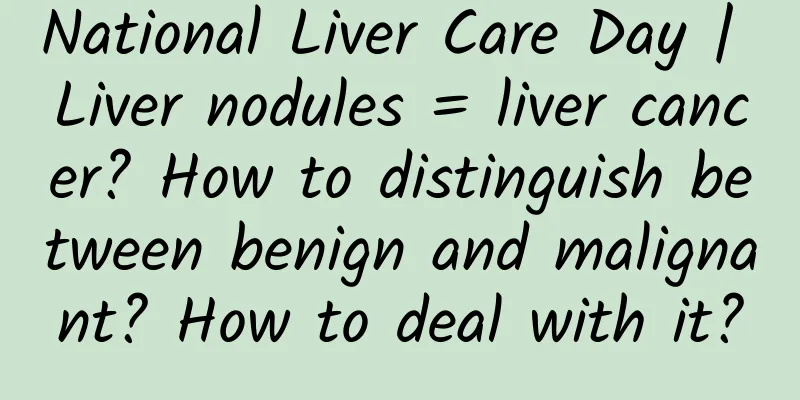National Liver Care Day | Liver nodules = liver cancer? How to distinguish between benign and malignant? How to deal with it?

|
The hepatitis B virus does not kill liver cells directly. The cellular immune response caused by viral infection is the main cause of liver cell damage and inflammatory necrosis. The repeated occurrence or persistence of inflammatory necrosis is an important factor in the progression of chronic hepatitis B to cirrhosis and liver cancer. In my country, liver cirrhosis and liver cancer caused by hepatitis B virus account for 60% and 80% respectively. Therefore, chronic hepatitis B patients have a great fear of the occurrence of liver nodules. Hepatitis B patients may have questions and concerns - does the recent discovery of liver nodules mean liver cancer? What should I do if I find liver nodules? This article will answer these questions for you. What are liver nodules? Liver nodules refer to growths in the liver that occupy part of the liver. Liver nodules are often round and are usually found through imaging tests such as color ultrasound, CT, and MRI. In fact, liver nodules is a general term, including both benign and malignant liver nodules in the liver. Not all liver nodules in hepatitis B patients are liver cancer. What are the common new liver nodules in patients with chronic hepatitis? Newly developed liver nodules in patients with chronic hepatitis B mainly include regenerative nodules (RN), atypical hyperplastic nodules (DN), hepatocellular carcinoma (HCC), and benign liver space-occupying lesions (FNH)-like nodules. Hepatic regenerative nodules are nodules caused by the proliferation of fibrous tissue in cirrhosis, destruction of the normal liver structure, and formation of pseudolobules. Image source: Pixabay Liver atypical hyperplastic nodules refer to nodular hepatocyte hyperplasia accompanied by hepatocyte degeneration without malignant signs, and are precancerous lesions. Atypical hyperplastic nodules are divided into low-grade atypical hyperplastic nodules and high-grade atypical hyperplastic nodules. Liver cancer refers to a malignant tumor of the liver that is pathologically composed of epithelial cells differentiated from hepatocytes. It is divided into small liver cancer and large liver cancer. Small liver cancer usually refers to a lesion with a diameter of less than 5 cm, and large liver cancer refers to a lesion with a diameter of more than 5 cm. Benign space-occupying nodules of the liver are benign liver nodules that occur in cirrhotic livers. They are composed of proliferating hepatocytes and are a reactive proliferation of hepatocytes to local vascular abnormalities. Are all new liver nodules in patients with chronic hepatitis malignant? Liver nodules caused by chronic hepatitis B and other factors develop from regenerative nodules to low-grade atypical hyperplastic nodules, then to high-grade atypical hyperplastic nodules, and finally to early liver cancer and even advanced liver cancer. The above process is considered to be a process in which cirrhotic nodules gradually change from benign to malignant, with no absolute boundary. This continuous process is consistent with the multi-step evolution of 80% of liver cancer. Hepatic regenerative nodules and benign hepatic space-occupying lesions are benign lesions. Hepatocellular carcinoma is a malignant lesion. Atypical hyperplastic nodules are considered precancerous lesions. The natural course follow-up process showed that the malignant transformation rates of high-grade atypical hyperplastic nodules were 3.5%, 15.5%, 31% and 48.5% within 1, 2, 3 and 5 years, respectively. How should patients with cirrhosis who are found to have dysplastic nodules be monitored? For nodules less than or equal to 1 cm, it is recommended to recheck every 3 months; For nodules larger than 1 cm or alpha-fetoprotein (AFP) > 20 ng/mL, an enhanced liver cancer screening program should be initiated, and enhanced MRI examination should be selected. The deterioration of cirrhosis nodules is part of the disease progression process. In order to prevent nodule deterioration, chronic liver disease should be detected early and treated in a timely manner to block disease progression and thus prevent liver cancer. If the nature of a liver nodule is difficult to determine by imaging examination, diagnostic liver biopsy should be considered. How to choose the examination? Which one is more suitable? When patients with chronic hepatitis B develop new liver nodules, they need to pay enough attention. With the advancement of diagnosis and treatment technology, even patients with liver cancer still have a good long-term survival if they are diagnosed and treated early. Image source: Pixabay When new liver nodules are found, imaging examinations should be performed immediately to confirm the diagnosis. Clinically, common liver examinations include ultrasound, CT, and MRI. For patients with chronic hepatitis B, it is recommended to perform relevant imaging examinations every 3 to 6 months. 1Ultrasound examination Ultrasound examination is one of the most widely used imaging methods in clinical practice due to its convenience, real-time and radiation-free advantages. It is used as the preferred screening tool for liver diseases. However, in the context of liver regeneration nodules in cirrhosis caused by chronic hepatitis B, it is challenging to identify atypical hyperplastic nodules and liver cancer. 2 Ultrasound contrast imaging Ultrasound contrast imaging can dynamically observe the blood perfusion of liver lesions and is currently also used in the diagnosis of early liver cancer. 3 Enhanced CT examination Enhanced CT examination is a method recommended by the guidelines. Compared with ultrasound, it has higher spatial resolution. After rapid intravenous bolus injection of contrast agent, liver arterial phase, portal venous phase and equilibrium phase scans are performed at different delayed time points. It can be used to analyze the enhancement pattern and degree of lesions, evaluate the hepatic artery and portal vein blood supply of the lesions, and help with the qualitative diagnosis of lesions. Image post-processing technology can also be used to display the hepatic artery, portal vein and other blood vessels as a whole and intuitively. However, CT has a certain amount of radiation and is not sensitive enough for the differential diagnosis of some highly atypical proliferative nodules and early liver cancer. 4 Magnetic resonance imaging Magnetic resonance enhanced scanning has a high soft tissue resolution. Through multi-sequence imaging, it can effectively identify different types of nodules, especially lesions with a diameter of ≤2 cm, which is better than ultrasound and CT enhancement. At the same time, magnetic resonance imaging can also accurately assess whether liver cancer invades the portal vein, hepatic vein, and abdominal and retroperitoneal lymph node metastasis. When hepatitis B patients are found to have liver nodules, it is recommended to give priority to MRI examination. If MRI enhancement cannot make a clear diagnosis, the latest "Multidisciplinary Expert Consensus on the Diagnosis and Treatment of Precancerous Lesions of Hepatocellular Carcinoma (2020 Edition)" recommends a more reliable method for differential diagnosis or screening of intrahepatic nodules: hepatobiliary specific contrast agent enhanced MRI, also called promecon-enhanced MRI scan. 5. Hepatobiliary specific contrast agent enhanced MRI CT and MRI contrast agents are extracellular contrast agents, while hepatobiliary specific contrast agents have the properties of both extracellular contrast agents and hepatocell-specific contrast agents. In addition to the conventional three-phase arterial enhancement (arterial phase, portal phase, and equilibrium phase), they also have a unique hepatobiliary specific phase. It has a high specific recognition ability for various types of nodules, and is particularly advantageous in the detection and differential diagnosis of tiny lesions (≤1 cm in diameter). The use of hepatocellular-specific contrast agents can improve the detection rate of liver cancer with a diameter of ≤1 cm, as well as the accuracy of diagnosis and differential diagnosis of liver cancer. It can significantly improve the diagnostic sensitivity of micro-liver cancer and help identify precancerous lesions such as highly dysplastic nodules. In short, new liver nodules in patients with chronic hepatitis B are not necessarily cancer. If you find liver nodules, don’t think that you have an incurable disease, and don’t rush to seek medical treatment. The correct choice is to go to a regular hospital for examination, clear diagnosis and treatment as soon as possible. Source: Editorial Department of "Liver Doctor" Author: Yuan Jie and Tan Wenli, Shuguang Hospital Affiliated to Shanghai University of Traditional Chinese Medicine Review expert: Li Shiying, The Second Affiliated Hospital of Chongqing Medical University Statement: Except for original content and special instructions, some pictures are from the Internet. They are not for commercial use and are only used as popular science materials. The copyright belongs to the original author. If there is any infringement, please contact us to delete them. |
Recommend
7 tips from McDonald's for successful marketing on Pinterest
Pinterest is rapidly growing into a new star that...
Why does I have a low fever during ovulation?
A low fever does not mean that the body temperatu...
I went back to work 4 days after induced labor
We all know that women need to take a month off a...
What to do if the anterior and posterior wall bulges after childbirth
In fact, natural childbirth is a method of delive...
Can female spondylitis be cured?
Female spondylitis can be cured. The main thing i...
How fast does a uterine fibroid grow before it turns malignant?
Malignant tumors grow faster than healthy tumors....
Eating more vegetables is good, but you may have been eating them wrong! Do these 6 things to eat vegetables healthier
Green is the color of spring and also the color o...
What causes pelvic abscess?
Pelvic abscess may be caused by gynecological dis...
What to do if pregnant women have carpal tunnel syndrome?
Pregnancy is a happy thing, but if you unfortunat...
Can hematuria be real or fake? Here's how to tell the difference!
Many people think that red urine means hematuria,...
Why can toilet water repel mosquitoes? How long does toilet water repel mosquitoes?
Mosquito repellent floral water is easy to carry ...
What to do if you discover uterine fibroids
Female friends are often troubled by the discover...
Why do I have breast pain before my period?
Many women experience breast pain before each men...
Why is the vaginal discharge a little brown?
People's concept of health is gradually gaini...
Back pain at 40 weeks of pregnancy
The 40th week of pregnancy is a very dangerous pe...









